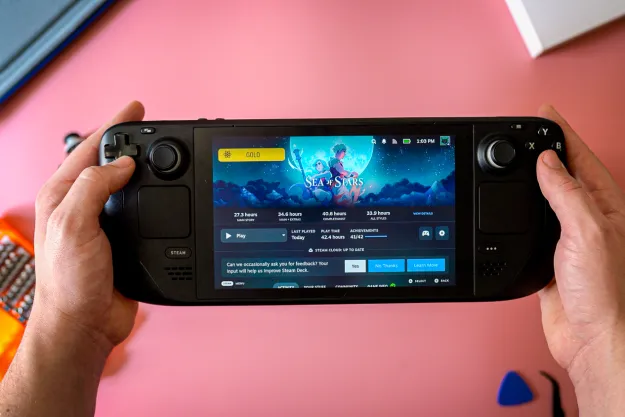“The Linksys NSLU2 has many significant problems, but ironically, is a very usable and stable device...”
- Easy setup; reliable; expandable
- Limited capacity; poor documentation; inconsistent performance
Summary
If you’re looking for a simple out of the box NAS solution, the Linksys NSLU2 is a good all around contender. Novices will appreciate the easy default setup, while pros will benefit from the extensive open source initiative surrounding “The Slug.” However, limited supported capacities and only 2 USB ports make other offerings very attractive options if you don’t want to void the warranty.
Features and Design
At one point or another, everyone outgrows their computer’s hard drive capacity. Whether music, movies, or games, the glut of information is making hard drives swell with exhaustion. Or perhaps the slow and steady progression of stable and usable Linux builds has piqued your interest, but you don’t want to give up a considerable chunk of drive space. There’s always the option of adding another hard drive, but what if you want to be able to access media and documents from any computer in the house, without having to keep a PC powered 24/7? This is where the NAS comes in.
NAS, or network attached storage, is actually a general term for a device that can access a network, with or without a full PC tethered to it. There are three options to choose from:
1) A dedicated PC with either Windows or Linux installed. If your electricity bill and available space are of no concern, this option offers the most flexibility.
2) A NAS adapter. These devices either plug into an Ethernet port on your router (or switch), with some offering wireless access.
3) NAS enclosures. These look just like external hard drives that you may plug into a USB or Firewire port, but include an Ethernet adapter. Careful when choosing an enclosure, as some have specific OS requirements.
The Linksys NSLU2 falls into the category of NAS adapters and has many advantages. The drives attached to the NSLU2 can be swapped out, upgraded, and attached directly to PCs (or Macs) for faster access. The device itself uses a flavor of Linux, which should thrill computer pros, and scare consumers. Don’t worry. All the details are hidden and only a few hoops must be jumped through in order to access the advanced options.
Out of the box, you get the NSLU2 device, a power adapter, Ethernet cable, vertical stand, and instruction manual. The device itself is very small, measuring 5″x3.5″x 1″ and sports status lights along the top-front edge. The only ports are located along the back, and include an Ethernet port and two USB 2.0 ports. The front contains a single power button. That’s it! The unit has a minimalist touch, which is the way a consumer device should be. However, under the hood there is a truckload of functionality.
The Linksys NSLU2
Setup and Use
Setup is very straightforward, except for the configuration we will discuss later. Just plug the Ethernet cable into your router, attach a couple hard drives, and boot the NSLU2. After 30 seconds, you hear a beep indicating you are ready to go. In order to access your files, you need to setup the network identity and IP address. This can be done through a slick browser interface. While the device does support Fat32 and NTFS, most of the more interesting options are only available to the router’s native ext2 file system. These include quotas, permissions, and users/groups options. After all your options are set, drives are visible under Network Places.
Copying small files is moderately efficient, but larger files, over 1GB, tend to drag on. Also, the maximum supported file size is 2GB, due to the limitation inherent to the Fat32 file system. Copying 24 files totaling 101MB took 22 seconds, a single 100MB file took roughly the same amount of time, and a 350MB file took 1.25 minutes. A 1.35GB file, which at the previous rate should have taken 4.8 minutes, took 5.5 minutes. There is a simple mod that will void the warranty, which significantly increases the speed of transfers to and from the Slug. The processor is underclocked by default, and the removal of a single diode from the motherboard restores the default processor speed. The difference is very noticeable once the 133MHz processor is firing at a full 266MHz, performing twice as fast in some tests. Keep in mind, though, that transfers will always be lower than writing directly to a PC hard drive, since you are limited to 10Base10/100 and USB 2.0 speeds. There is currently no Slug with gigabit Ethernet support or Firewire 400/800. We performed the un-underclocking mod and have had a stable system for 4+ months. The above speed test reflects the regular-clocked NSLU2 performance.
Drive capacity limits are a little disappointing. The maximum supported drive size is 250GB for each port. What’s more, attaching a USB hub causes numerous problems, and is mostly unworkable. The underlying Linux subsystem can be accessed over Telnet and custom firmware can be installed, but again, you risk voiding the warranty. However, even with a firmware flash, the maximum drive capacity is still 250GB. This is due, in part, to the Slug’s disk checking and backup programs, which require a certain amount of RAM per MB of drive space. Should the unit power down improperly while using a drive larger than the recommended maximum, you run the risk of irreversibly losing data (as it is limited to only 32 MB of memory).
Linksys NSLU2
Currently shipping NSLU2s have the latest firmware installed, which is both good and bad. In the drive to make the device more suitable to average consumers, Linksys recently added support for FAT32 and NTFS, the two major drive formats supported in Windows, and the defaults of many external hard drive manufacturers. In previous versions, users had to reformat any drives attached to ext2, which is the default Linux format. On the surface, the additional formats sound like a good thing, but the implementation was slightly botched. According to Linksys tech support, the first USB port is meant to be readable and writable, and the second port only readable. There is no explicit reason for this setup, and it is not documented. Furthermore, this limitation does not exist for drives formatted in ext2. What’s worse, these read/write limitations are not held up consistently. We had a discussion with tech support, during which we were clearly capable of doing things that we were not supposed to be able to do. So, the moral of the story is this: reformat to ext2. All of our headaches were relieved by simply following the most basic setup for the device. We are not letting Linksys off the hook for this snafu, as even though the problems with Fat32 and NTFS support are well documented, the firmware revisions have sat stagnant since July of 2005.
The Administration Screen
While this may appear to be a bleak of the poor Slug, the device, with the drives formatted to ext2, is a nice, stable solution for home users. The biggest boon is for homes with multiple PCs that want to share music or documents. Users can be allotted limited space, given specific access privileges, and allowed to access files without leaving a full PC on when no one is using it. The speed of the Slug, while slow, is sufficient to stream music, which means a single mp3 database can be kept accessible to Media Center PCs and laptops throughout the house. We were also able to stream high definition video in Divx, MPEG4, AVI, and Xvid to our Media Center PC with only some minor stuttering. We cannot fully recommend it for video streaming, since many demanding users will find the stuttering too distracting, and simultaneous writing from another computer causes the playback to suffer considerably, but know that it can be done.
Another note for Windows users: Windows does not natively recognize ext2 formatted drives, but there are freeware utilities that allow reading and writing to these drives. Check out the forum discussion associated with this review for more details. But, be aware that once you format your drives to ext2, Windows disk recovery utilities will no longer work, and the drive cannot be detached or plugged into PCs without the driver. One way around this is to have the driver on a USB key if you keep one handy. If you find yourself faced with a PC lacking ext2 support, you can install it yourself.
The NSLU2 Backup Screen
Conclusion
The Linksys NSLU2 has many significant problems, but ironically, is a very usable and stable device, as long as you play the game the way Linksys wants you to. Fat32 and NTFS support are poor, at best, but ext2 shines. Transfers are slow, but not unmanageable, and overall the promise of a simple, network storage device is realized. Drive capacities may be disappointing to some, but for simple backups and media access the Slug may be slow; since our last configuration 4 months ago, it hasn’t required a single reboot. If Linksys were to address these problems, we could easily see the Slug slither up to a 9/10 rating.
Pros:
- Easy setup
- Stable
- Expandable
Cons:
- Limited capacity
- Poor documentation
- Inconsistent performance
Editors' Recommendations
- The 10 best monitors for 2024: tested and reviewed
- 9 best processors for PC gaming: tested and reviewed
- Quest Pro 2: What we know about Meta’s next premium VR headset
- 10 best gaming monitors of 2024: tested and reviewed
- Best color laser printers for 2024: tested and reviewed








